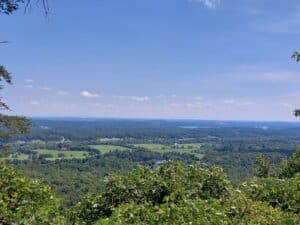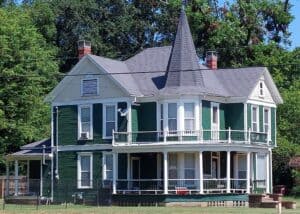When you go on vacation, do you notice what’s around you or do you “wear blinders” and just focus on getting to your destination?
The Trip
Last week I drove Mom to South Carolina for a reunion with her three sisters. We took I-10 east through Louisiana and Mississippi. The traffic and roadwork made for slow going. So much so, we detoured off the interstate and onto U.S. 90 in Mississippi. Even contending with traffic lights in the beach towns, the travel was faster than the interstate. The houses on the water from Bay St Louis through Gulfport to Biloxi were beautiful, and the beaches were surprisingly empty for a hot summer day. Still nothing out of the norm, at least nothing that caught my eye. Not until we turned north on I-65 in Alabama.
The Waterways
The number of rivers caught my attention first. It seemed like we crossed one every mile or so. I hadn’t expected that. In Louisiana, yes. It seems like I-10 is mostly over water, but this was Alabama. I watched for their names, thinking it might be the same river winding back and forth. It wasn’t. Each bridge crossed a different river or creek and a couple had me doing a double take, specifically Burnt Corn Creek and Murder Creek.
My writer’s inquisitive nature demanded to know how they got their names. So, I looked them up the first chance I got. What I learned is no one knows precisely how Burnt Corn Creek got its name, though there are several stories about burning corn. One claims the white settlers burned the Native Americans’ corn, while another claims the Native Americans burned the white settlers’ corn. (These are just two of the stories about how the creek got its name. To read the others, click here.) As for Murder Creek, or Murder River, the name derives from the gruesome murders that happened along its banks back in 1788. (To read this story, click here.)
Did You Know…
- There is a small community named Burnt Corn. It may have been founded in the early 1700s, long before the U.S. became a country, and is one of Alabama’s oldest settlements.
- One of the U.S.’s first “highways,” the Old Federal Road, passed through Burnt Corn.
- From 1805-1811, stagecoaches traveling between the Gulf Coast port cities and the east regularly stopped in Burnt Corn.
The Animals
Throughout the trip, we saw the expected animals: cats, dogs, birds, squirrels, chipmunks, goats, cows, and horses. However, we also saw a few not so expected animals. In Georgia (or maybe we were already in North Carolina), we saw a giraffe standing next to a large pink elephant wearing sunglasses. (I swear, no drinking—other than water—was involved.) And in Tennessee, we drove by a giant yellow ducky. But the most extraordinary animal was the mounted T-Rex head we saw in Texas . . . and, as you can see, I do have a photo of it.

Mounted T-Rex
Did You Know…
- There are 322 species of crayfish in the U.S. That’s 61% of the known crayfish in the world!
- The Hatchie burrowing crayfish only resides along the Hatchie River in Tennessee.
- Jefferson, TX, has two Wildlife/Safari parks—Busy B Ranch Wildlife Park and Lonesome Dove Drive-Thru Safari.
The Countryside and Towns
From the beaches along the Gulf Coast, through the hills of the Carolinas, Tennessee, and Arkansas, we saw lots of beautiful country.

View of TN Valley
We delighted in the towns, both small and large, historic and contemporary, with their houses that ran the gambit of age and style.
Two places stood out on this trip, both happened to be in Texas. The first was the green “cypress” house in a small town south of Texarkana.

Cypress House
The original builder used cypress to construct this majestic old Victorian, and, in his will, stipulated that the house was never to be painted. However, after a number of years, this stipulation became null and void, and the house’s owner painted it.
Even more interesting is a newly built house a little further south in East Texas. This house holds two surprises for future plumbers and/or homeowners. Before the walls were finished, the current owners placed one Halloween skeleton in the wall of the master bathroom’s toilet area and one in the ceiling above the jack-and-jill bathroom on the other side of the house. One day in the distant future, when either plumbing issues arise or the house is torn down, someone is in for a scary surprise.
Did You Know…
- Cypress wood is desirable for outdoor projects and exterior construction because of its rot resistance, strength, and unlikeliness to cup, twist, or bow.
- In the mid-1800s, Jefferson, TX, was the U.S.’s largest inland port.
- At its peak, Jefferson was bigger than Dallas, and in Texas, only Galveston was a bigger commerce center. (For more information about historic Jefferson, click here.)
The Return
In the end, we covered 2,200 miles and nine states (TX, LA, MS, AL, SC, NC, GA, TN, and AR) in eight days. And though the main purpose of the trip was to visit family and friends in South Carolina and Tennessee, Mom and I both relished spotting those unusual sights and sites.
Next time you take a driving vacation, don’t forget to look around you when you travel. You never know what interesting things await.

